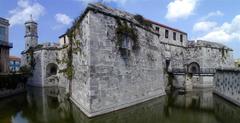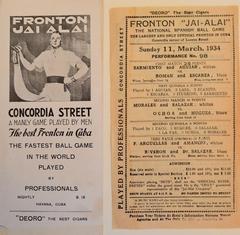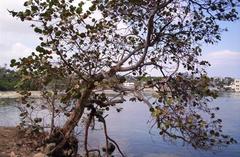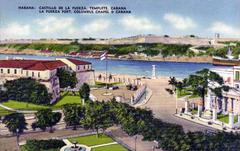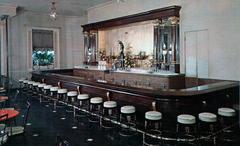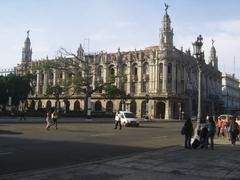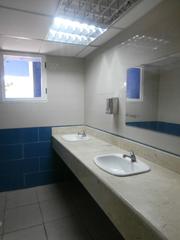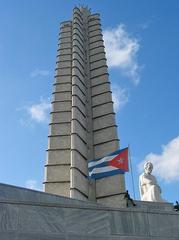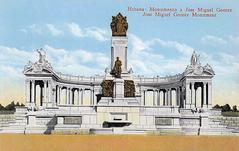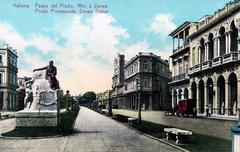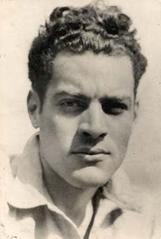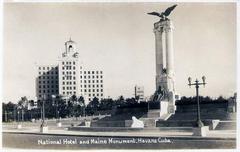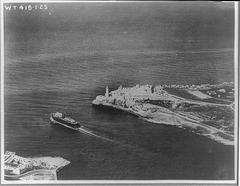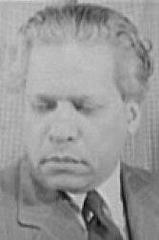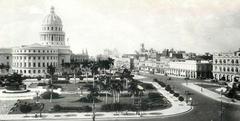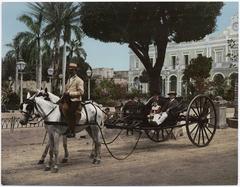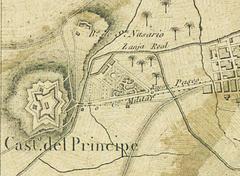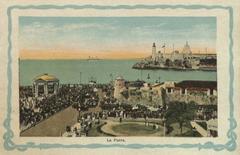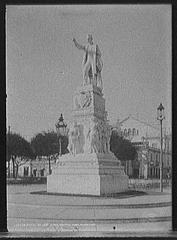
Bank of Nova Scotia Building, Havana, Cuba: Visiting Hours, Tickets, and Historical Sites Guide
Date: 04/07/2025
Introduction
Nestled in the heart of Old Havana, the Bank of Nova Scotia Building is a captivating testament to Cuba’s commercial legacy and architectural heritage. This iconic neoclassical structure, completed in the early 20th century, reflects Havana’s role as a vibrant hub for international trade, particularly during its golden era as a crossroads between the Caribbean, North America, and Europe. The building’s grand façade, with its imposing columns and intricate stonework, stands as a symbol of stability and prosperity—a visual reminder of the profound Canadian financial influence that helped shape Cuba’s economic landscape (CompaniesHistory.com).
Though the building’s interior is currently inaccessible to the general public due to its function as a government and banking facility, its exterior remains a must-see for history enthusiasts, architecture aficionados, and curious travelers alike. Located within Old Havana’s UNESCO World Heritage district, the Bank of Nova Scotia Building is surrounded by an array of significant plazas, museums, and cultural landmarks that together narrate the story of Havana’s evolution. This guide offers a comprehensive overview of the building’s history, architectural highlights, visitor tips, accessibility details, and recommendations for nearby attractions and photography opportunities.
For those seeking deeper insights, interactive tours, and the latest updates, consult Audiala, National Geographic, or CompaniesHistory.com.
Contents
- Early Foundations and Caribbean Expansion
- Arrival in Havana: Strategic Growth
- Architectural Evolution and Key Features
- Economic and Social Significance
- Impact of Political Change and Preservation
- Visiting Hours, Tickets, and Accessibility
- Nearby Attractions and Visitor Experience
- Practical Tips and Cultural Etiquette
- Frequently Asked Questions (FAQ)
- Conclusion and Recommendations
- References
Early Foundations and Caribbean Expansion
Founded in Halifax, Nova Scotia, in 1832, the Bank of Nova Scotia—today known as Scotiabank—was originally established to support trans-Atlantic commerce (CompaniesHistory.com). By 1889, the bank had expanded to the Caribbean, opening its first branch in Kingston, Jamaica, and soon after, further branches across the region. This expansion played a pivotal role in international trade of sugar, tobacco, and other vital commodities, reinforcing Canada’s economic ties to the Caribbean.
Arrival in Havana: Strategic Growth
The Bank of Nova Scotia’s entry into Havana in the early 20th century marked a significant chapter in Cuba’s financial history (CompaniesHistory.com). Havana’s branch quickly became a cornerstone for the sugar and tobacco trades, serving both local and international clients. The building located at Calle Cuba 225 was constructed between the 1920s and 1940s, designed to project confidence, reliability, and international prestige (Library of Congress).
Architectural Evolution and Key Features
Designed by architect Arthur Lobo and completed in 1906 (with later expansions in 1914), the Bank of Nova Scotia Building exemplifies the neoclassical style favored by financial institutions of that era (Fotos de la Habana). Its symmetrical façade is adorned with grand columns, ornate cornices, and a monumental stone logo, all intended to evoke the grandeur of ancient Greece and Rome (Cuba Explore).
Key Features:
- Materials: Durable stone, marble, and wrought iron
- Design Motifs: Classical columns, reliefs symbolizing prosperity, intricate ironwork
- Interior (historical): High ceilings, marble floors, period lighting fixtures, and decorative moldings (now inaccessible due to current use)
- Location: Calle Cuba 225, at the intersection with Calle O’Reilly, within Old Havana’s historic core
Economic and Social Significance
Beyond its architectural merit, the Bank of Nova Scotia Building played a crucial role in facilitating international trade and providing financial services to Cuba’s burgeoning commercial sector. It supported sugar industry financing and counted among its clients notable figures such as Julio Lobo Olavarría (Fotos de la Habana). Its presence underscored Havana’s position as a cosmopolitan center open to global commerce.
Impact of Political Change and Preservation
The Cuban Revolution of 1959 and subsequent nationalization efforts transformed the country’s financial sector, with most foreign banks—including the Bank of Nova Scotia—seeing their operations curtailed or repurposed (Canadian Coin News). Despite these changes, the building’s architecture has been carefully preserved, and it remains a prominent feature in Old Havana’s urban landscape.
Today, it operates as a branch of Banco Metropolitano. While interior access is limited, the structure is often included in guided walking tours and highlighted in heritage conservation efforts (VisitCuba.com).
Visiting Hours, Tickets, and Accessibility
- Exterior Viewing: Open year-round, best experienced during daylight (9 AM – 6 PM). The building can be admired from the street at any time.
- Interior Access: Not available to the public; entry is restricted to bank staff and customers.
- Tickets: None required for exterior viewing; guided tours of Old Havana may charge a separate fee (Trek Zone).
- Accessibility: The surrounding area is pedestrian-friendly but features cobblestone streets that may challenge those with limited mobility. Interior accessibility is not provided.
- Photography: Permitted from the street; early morning and late afternoon offer the best lighting for photos.
Nearby Attractions and Visitor Experience
The Bank of Nova Scotia Building’s central location makes it an excellent starting point for exploring other Havana historical sites:
- Museo Nacional de Bellas Artes: Cuba’s national art museum, just eight minutes away (Trek Zone).
- La Bodeguita del Medio: Legendary bar and Hemingway haunt, two minutes away.
- Museum of the Revolution: Key site for learning about Cuba’s modern history.
- Havana Cathedral: Baroque masterpiece within walking distance.
- Gran Teatro de La Habana: Home to ballet and cultural performances (The Tourist Checklist).
Dining Options: Enjoy local and international cuisine at paladares such as Doña Eutimia, NAO Bar Paladar, and La Bodeguita del Medio (Cuba Explore).
Practical Tips and Cultural Etiquette
- Currency: Bring euros or Canadian dollars for exchange; U.S. dollars are not widely accepted. Credit card use is limited (Lonely Planet).
- Language: Spanish is the official language; basic phrases or translation apps are helpful (Under30Experiences).
- Safety: Havana is generally safe; keep valuables secure and ask permission before photographing people or private spaces.
- Dress: Casual attire is suitable; formal wear is required in upscale venues. Avoid beachwear away from the coast.
- Travel Insurance: Proof is required for entry into Cuba (Lonely Planet).
- Best Visiting Season: November to April (dry season) for pleasant weather and cultural events (Audiala).
Frequently Asked Questions (FAQ)
Q: Are there tickets or visiting hours for the Bank of Nova Scotia Building?
A: No tickets are required. The exterior can be viewed at any time; interior access is restricted.
Q: Is the building wheelchair accessible?
A: The surrounding streets are pedestrian-friendly but cobblestoned; interior access is not available.
Q: Can I take photos of the building?
A: Yes, photography of the exterior is welcomed.
Q: Are guided tours available?
A: Yes, many walking tours of Old Havana include the building and provide historical context (Audiala).
Q: What currency should I bring?
A: Euros and Canadian dollars are preferred for exchange.
Conclusion and Recommendations
The Bank of Nova Scotia Building is a remarkable symbol of Havana’s international financial heritage and architectural grandeur. While you cannot enter the building, its neoclassical façade and strategic location make it a highlight of any Old Havana itinerary. Enhance your visit by joining a guided walking tour, exploring nearby museums and plazas, and immersing yourself in Havana’s vibrant street life.
For personalized maps, guided experiences, and event updates, download the Audiala app. Stay tuned to trusted sources and social media for the latest travel tips and cultural insights. Embrace the opportunity to explore this architectural gem and the living history that surrounds it in Cuba’s capital city.
References
- CompaniesHistory.com - Scotiabank
- VisitCuba.com
- National Geographic - Havana Travel
- Audiala - Old Havana
- Fotos de la Habana - Bank of Nova Scotia
- Trek Zone - Bank of Nova Scotia Building Havana
- Cuba Explore - Bank of Nova Scotia Attraction
- The Tourist Checklist - Things to Do in Havana
- Under30Experiences - Visiting Havana Tips
- Lonely Planet - Traveling to Havana
- Canadian Coin News - RBC and Bank of Nova Scotia in Cuba
- Library of Congress - Bank of Nova Scotia Building


